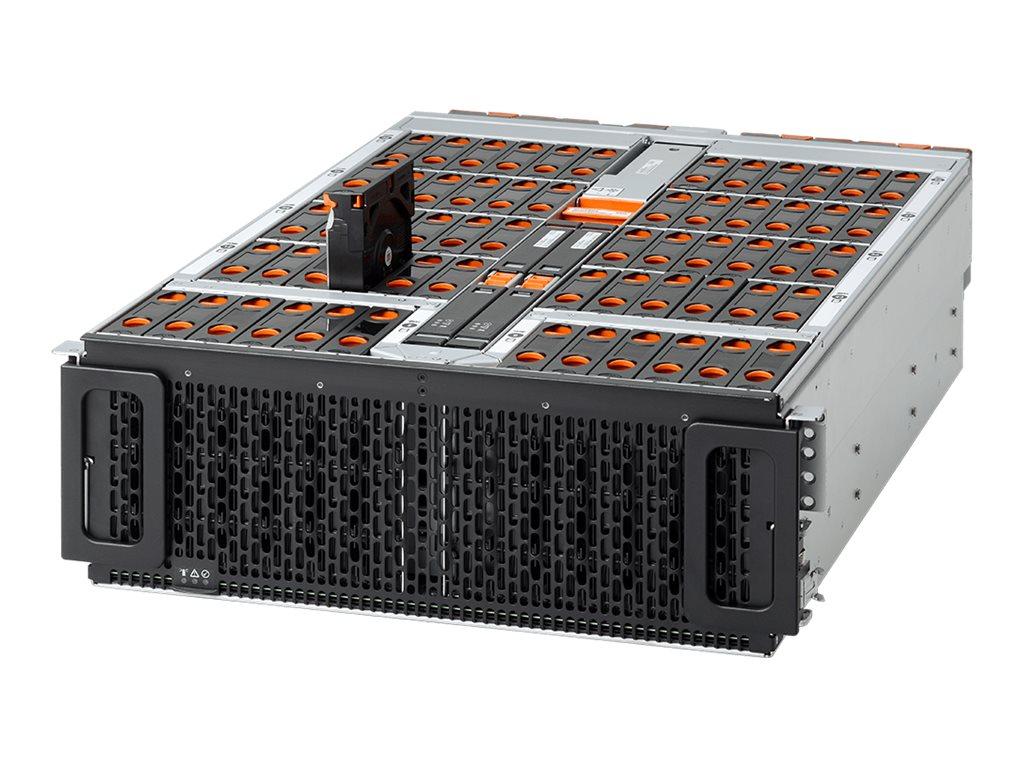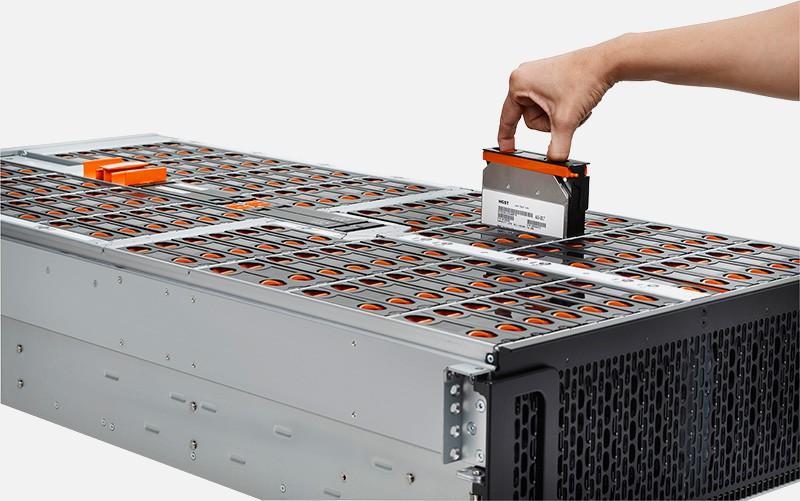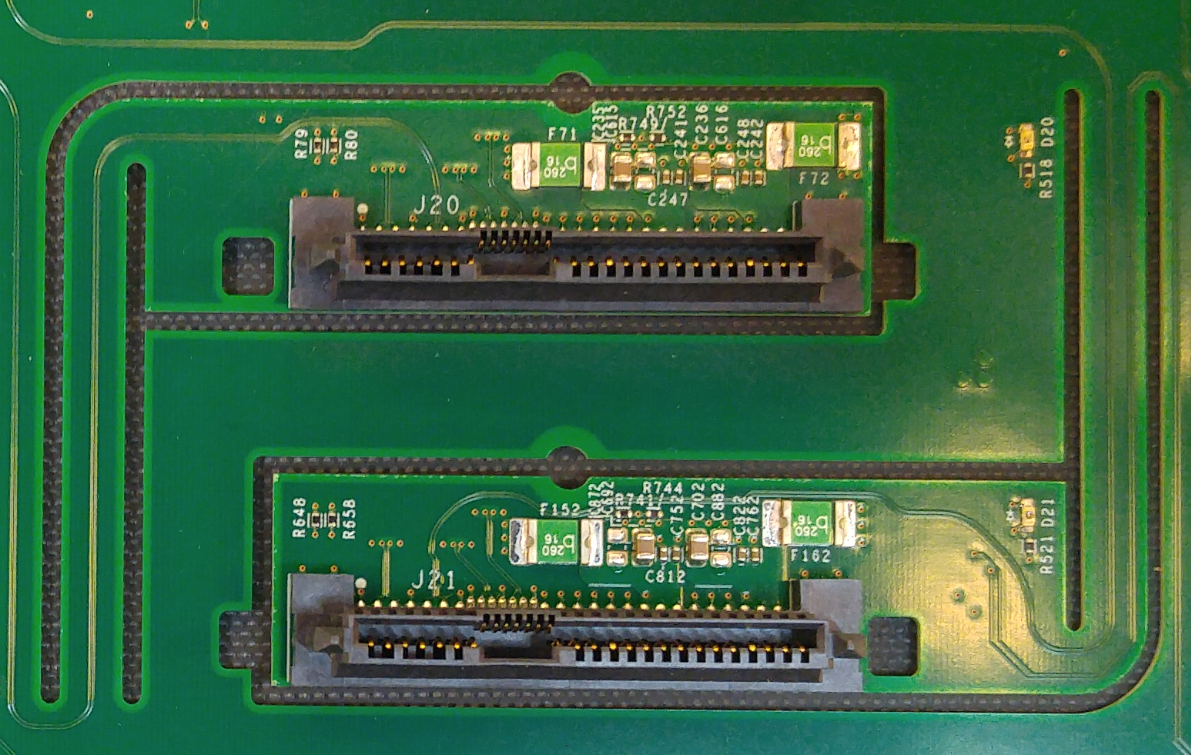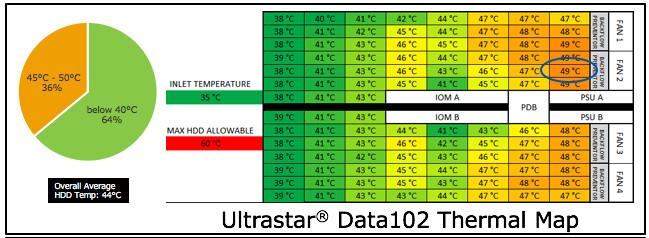
In today's world, information is the most valuable asset. Information helps you optimize business processes, analyze the market and make strategic decisions that shape the future of your company, and even build trust with your customers, increasing their loyalty. However, as the volume of processed data grows, any enterprise inevitably faces the problem of lack of storage space. In situations where it is not computing power that comes to the fore, but the amount of available disk space, JBOD disk shelves are the most cost-effective solution for scaling IT infrastructure. It is about them that we will talk in today's article.
Key advantages of the Ultrastar Data hardware platform
Western Digital offers two models of Ultrastar JBOD arrays - Data60 and Data102. These modifications are completely identical in terms of the technologies implemented in them and differ from each other only in capacity, which is eloquently indicated by the numerical index in the name: the younger model is able to accommodate 60 3.5-inch SAS (12 Gb / s) or SATA (6 Gb / s ) drives, while the flagship has up to 102 drives. Thus, one Ultrastar Data60 disk shelf can store up to 840 RAW data, and the maximum capacity of Ultrastar Data102 can already reach 1.4 petabytes (when using Western Digital Ultrastar DC HC 530 hard drives with a capacity of 14 TB each). At the same time, 24 of the available bays can be used to install SAS or SATA solid-state drives,to achieve the optimal balance between capacity and performance by leveraging JBOD in scenarios where high availability is at the fore.
When designing the Ultrastar Data series disk shelves, we paid special attention to combating the negative effects of vibration and high temperatures on the functioning of the system. The result of the work of Western Digital engineers was the emergence of two assistive technologies at once, which significantly improved the operational characteristics of the JBOD: IsoVibe and ArcticFlow. Let's consider each of them in more detail.
IsoVibe Rotary Vibration Suppression Technology
IsoVibe is designed to neutralize the detrimental effect of rotational vibration that occurs when the HDD spindle spins on the performance of the array. Recall that when the magnetic head is displaced from the track under the influence of external factors, the disk microcontroller is forced to initiate the positioning procedure again, due to which the data read / write time significantly increases. So, for example, when a working hard drive is exposed to rotational vibration with an angular acceleration of 50 radians / sec2, the loss of performance can exceed the threshold of 70%. In the case of JBOD, this problem becomes even more acute, since due to the high density of the drives in a relatively compact case, their mutual influence on each other increases many times over.
Technological solutions implemented in the framework of IsoVibe are aimed at preventing the propagation of vibration between the bays of the disk shelf, which can be guessed already from the name of the technology itself, which is an acronym for the English phrase "isolated from vibration." So, during the design of Ultrastar Data, we completely abandoned the use of screw fasteners: now the drives are fixed using shock-absorbed mini-sleds, which not only simplifies the process of installing and replacing disks, but also significantly reduces the effect of resonance inside the case and localizes vibration within one compartment.

The
vibration-insulated connectors located on the rear panel of the JBOD also contribute to the vibration-damped skids , which minimized the propagation of high-frequency mechanical vibrations due to the slots in the backplane PCB.

Slots in the backplane PCB reduce vibration propagation inside the JBOD The
intelligent firmware of Western Digital Ultrastar hard disk microcontrollers, which we recommend to use with JBOD arrays, which supports RVS (Rotational Vibration Safeguard) technology, completes the picture. A specialized algorithm monitors the signals coming from the built-in multiaxial accelerometers and calculates in real time the compensation forces required to correct the trajectory of the magnetic head unit.

How RVS Rotational Vibration Compensation Works
Compared to conventional HDDs, RVS-enabled drives provide up to 20x the performance gain, even in the most demanding operating conditions.
Cooling system ArcticFlow
Another well-known problem of disk shelves, namely overheating of drives located in the back rows, was successfully solved thanks to the unique chassis architecture, which received the trade name ArcticFlow. As with vibration, when it comes to air cooling, the main problem is too dense arrangement of drives in several rows. And since most models circulate air from the front of the chassis to the rear, passing through the first rows, the air heats up, as a result of which the cooling efficiency of the rear rows is significantly reduced.
Ultrastar Data solves this problem as follows. The disk shelf is divided into two cooling zones (4 rows each), isolated from each other. The air flows that provide ventilation to the front area are removed from the body through bypass ducts that go around the rear compartment on the sides. As for the rear rows, a separate air duct is provided for their cooling, located in the center, the air from which flows directly to the rear rows of the accumulators, from the 5th to the 8th. In addition, a separate flow of cold air is supplied directly to the power supplies and I / O modules located behind.

Air circulation pattern inside Ultrastar Data disk shelves
This design has helped to achieve truly impressive results. ArcticFlow has significantly reduced the temperature difference between the front and rear zones: the spread between them does not exceed 10 ° C. When using Ultrastar drives, created on the basis of the fourth generation HelioSeal platform (for more information about the technologies used in the production of hard drives for data centers, you can read the article "Brighter than the stars"), at the "hottest" area, which is the 8th row adjacent to the power supply bays, the maximum HDD temperature does not rise above 49 ° C. At the same time, an average of 1.6 W of electricity is spent on cooling each of them, which is two times less than that of competing models.

Thus, ArcticFlow solves 3 tasks simultaneously:
- effective cooling helps to extend the life of the drives installed in the JBOD, and also completely eliminates the possibility of their failure due to overheating;
- there is no need to install powerful, high-speed coolers, which also helps to reduce the overall level of vibration, which negatively affects both the state of the equipment and its performance;
- lower power consumption can significantly reduce the operating costs of maintaining a data center equipped with JBOD Ultrastar.
Building a cloud infrastructure using Ultrastar disk shelves using the example of Acronis
Who is the Western Digital Ultrastar disk shelf for? The first thing that comes to mind is cloud services operating with huge amounts of data. As their business expands, such companies inevitably face an exponential increase in the cost of scaling and maintaining IT infrastructure, which turns out to be the more, the more complex the latter is organized.
In particular, these problems are typical for rapidly growing enterprises using a SaaS-based model of providing cloud services: in an effort to keep up with a changing market and at the same time maintain profitability, many of them use several disparate solutions at the same time. In the first couples, such an approach is indeed capable of providing certain benefits, but in the long term, this leads to a significant increase in the costs of managing, maintaining and further scaling the existing infrastructure.
Here, the experience of Acronis, which specializes in providing cloud-based cybersecurity solutions for corporate and private clients, is very indicative. Today the company owns 14 data centers in different parts of our planet, the capacities of which are used in their work by over 500 thousand enterprises.

In an effort to increase storage capacity while optimizing maintenance costs, Acronis faced a number of significant challenges due to the lack of a unified hardware platform. The company turned to its longtime technology partner, DIAWAY, for help. To predict capital and operating expenses, the system integrator created a thorough financial model for the next 5 years. Having compared the offers presented on the modern market, DIAWAY specialists came to the conclusion that the hybrid storages Western Digital Ultrastar Data60 and Data102 would be the most optimal option for the implementation of such a project.
This year, the company completed the migration of its cloud infrastructure to Ultrastar disk shelves, and according to Alex Beik, director of global technical operations at Acronis, the move paid off. Migration to the new platform provided a number of key benefits, among which it is necessary to highlight:
- Reduced TCO
With the move to Ultrastar hybrid storage, Acronis has achieved significant CAPEX and OPEX savings, with storage costs per terabyte reduced by more than 25%.
- Improving the reliability of storage systems
Ultrastar JBODs' advanced cooling and vibration isolation technologies, combined with redundant power supplies and hot-swappable I / O modules, have helped to dramatically improve the resiliency of both the DAE and storage infrastructure.
- Ease of service
Global architecture standardization has simplified planning for further storage capacity expansion and streamlined management of Acronis' vast IT infrastructure: today, the company's specialists use unified tools and algorithms to solve the assigned tasks, and if necessary, they can turn to Western Digital engineers at any time.
Examples of deploying a backup system based on Western Digital Ultrastar Data60 and software from Veeam Software
However, one should not think that Ultrastar disk shelves are focused exclusively on large companies and cloud providers: JBOD arrays can become an irreplaceable tool in the arsenal of small and medium-sized businesses. First of all, we are talking about the creation of high-capacity and productive backup systems, for the organization of which we offer a ready-made bundle in the form of Ultrastar Data60 / 102 and software developed by one of our strategic partners - Veeam Software, specializing in creating complex solutions in the field of backup copying data.

The motto of the company "It just works!" speaks for itself: Veeam strives to create simple, effective, and most importantly, reliable "set and forget" products, and they do it really well. It is no coincidence that in 2019 the total number of the company's clients exceeded 375 thousand, and its annual turnover exceeded the $ 1 billion mark.
When designing a backup system based on Ultrastar disk shelves and Veeam software, two approaches are most effective:
- on-premises - backups are created and stored on the basis of the company's own data center;
- on-premises + cloud tier — , « » , .

Each of them has its own advantages. The combination of self-hosted and cloud solutions allows you to easily scale your IT infrastructure as needed by connecting Amazon S3 object storage, Azure Blob Storage, IBM Cloud Object Storage, or any other S3-compatible service, and further save on long-term data storage, as well leaving an opportunity for disaster recovery in case of emergencies. On-premises, on the other hand, guarantees a quick recovery of any backups ever created, independence from external factors, a high level of privacy and compliance with local legislation in the event that the company's activities are in one way or another related to the processing of customer personal data.
The easiest way to demonstrate the effectiveness of a combination of Veeam software and Western Digital hybrid storage with specific examples. We have selected two of the most illustrative cases from our extensive practice.
Case No. 1
Client
The client was a large European manufacturer of household goods with an annual turnover of more than 500 million euros, with offices and production facilities located in different EU countries and in China. The company employs about 1,800 permanent employees, and the IT infrastructure is represented by 8 data centers around the world.
Problem
The hardware and software complex used by the customer to create backups ceased to adequately cope with the task assigned to it due to the manifold increased load, since it did not have sufficient bandwidth. In addition, there were some problems with the processing of tasks associated with the deduplication procedure, which led to frequent failures during the backup.
Finding a solution
The customer's IT department came to the conclusion that upgrading the existing backup infrastructure is not cost-effective, and therefore a decision was made to move to a new architecture, which would not only save money, but also solve the problem of scalability in the future. For the organization of the backup system, the hybrid storage Ultrastar Data60 from Western Digital was chosen, managed by the software Veeam Backup & Replication 9.5, Veeam Backup for Microsoft Office 365 and Microsoft Windows Storage Spaces (included in Windows Server 2016).
Configuration
The final hardware configuration consisted of an HPE Proliant DL360 G9 server equipped with a pair of Broadcom 9480-8i8e MegaRAID controllers serving Ultrastar Data60 I / O modules. Each RAID controller was connected to the designated I / O port using a 4-lane HD MiniSAS cable (P / N 1EX0329), providing up to 9.6 GB / s bandwidth per controller.

HPE Proliant DL360 G9 Server Platform
Disk storage was deployed with 60 12TB Ultrastar SAS HDDs for a total capacity of 720TB. Using T10 zoning, the Ultrastar Data60 was logically divided into two zones of 30 drives each, so that each controller only sees drives assigned to specific ports. In groups of 30 drives, the IT team created multiple striped volume sets that were grouped into a single shared volume using Windows Storage Spaces. One of these volumes was used for incremental backups, while the other contained a full backup image that was further compressed using Windows Server deduplication.
results
A bundle of 1 × server + 2 × RAID controllers + 1 × Ultrastar Data60 cost the customer significantly less than a dedicated backup device that supports internal deduplication. In the future, this platform can be easily scaled by daisy-chaining new disk shelves (up to four) without the need to upgrade the server platform.
Case No. 2
Client

GreenPower is a large enterprise specializing in the production of natural vitamin complexes and food supplements. The company owns the Dr. Hittich, and its headquarters are in Kerkrad (Netherlands).
Problem
GreenPower needed a reliable and efficient backup solution. Initially, servers with 24/36 bays were used for these purposes, and the total disk space allocated for backups was 108 terabytes. When this volume was no longer enough, the company faced the problem of scaling the IT infrastructure. Larger storage servers were too expensive and had to be abandoned. In turn, the idea of regularly replacing full disks with empty ones proved to be completely untenable: this approach could not provide the required level of backup availability, and errors in marking seized disks regularly led to difficulties in data recovery and even to their loss.
Configuration
It was decided to implement a backup system based on two servers with Veeam Backup & Replication 9.5 software and two Ultrastar Data60 disk shelves from Western Digital. Each hybrid storage was installed with 60 Ultrastar SAS HDDs of 6, 8 and 10 terabytes.

10 terabyte Ultrastar DC HC330 Data Center
Hard Drives The hard drives were configured into multiple RAID sets managed by Windows Storage Spaces. For data deduplication, Microsoft built-in software created several “Thin” virtual disks (this approach circumvented the 64 TB limit). As in the first example, the available disk space was divided into two logical volumes, one of which was used for creating full backups, while the other was intended for incremental backups.
results
The transition to the Ultrastar Data60 storage platform helped significantly reduce logistics costs, and in terms of a terabyte of information, the acquisition of disk shelves turned out to be a much more profitable solution compared to the purchase of full-fledged servers: since using the data deduplication function of Microsoft Windows Server 2016, it is possible to save about 1250 terabytes for every 378 TB of physical disk space, the capacity of one such shelf, taking into account the current needs of the company, is enough for 6 years of daily backups.
An equally important advantage turned out to be a significant increase in the performance of the backup system: the creation and restoration of backups occurs at a speed of at least 1 GB / s. This eliminates the occurrence of situations where Windows Server cannot complete data deduplication in existing backups before creating new ones. Previously, such collisions led to a significant decrease in the performance of the entire system, but the new platform made it possible to forget about them once and for all.